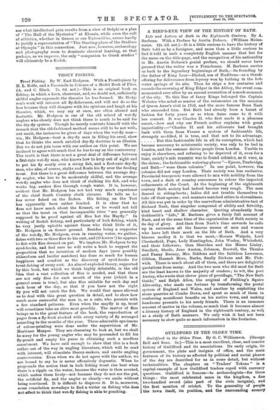Life and Letters at Bath in the Eighteenth Century. By
A. Barbeau. With a Preface by Austin Dobson. (William Heine- mann. 12s. ad. net.)—It is a little curious to have the history of Bath told us by a foreigner, and more than a little curious to find it told in such a completely English manner that but for the name on the title-page, and the recognition of his nationality in Mr. Austin Dobson's genial preface, we should never have guessed that the writer was a Frenchman. M. Barbeau carries us back to the legendary beginnings of Bath,—its founding by the father of King Lear—Bladud, son of Hudibras—as a thank- offering for deliverance from leprosy won by bathing in the hot- water springs of its site. Then he skips a few centuries and records the crowning of King Edgar in the Abbey, the event com- memorated ever after by an annual coronation of a mock-monarch of the city. To this line of fancy Kings belonged the Captain Webster who acted as master of the ceremonies on the occasion of Queen Anne's visit in 1702, and the more famous Beau Nash who succeeded him. But Bath had already been a haunt of fashion for forty years or so when Anne came to it with her consort. It was Charles II. who first made it a pleasure resort,—how and why our French author explains with great impartiality :—" Charles II. and his adherents had brought back with them from France a system of fashionable life, strangely modified, it is true, and that not to its advantage.
But this fashionable life in all its corruption, which had become necessary to aristocratic society, was only to be had in London, and the summer drives people from London. Unable to enjoy it elsewhere, and refusing to be deprived of it, even for a time, society's sole resource was to found colonies, as it were, in the shires ; the fashionable watering-places "—Epsom, Tunbridge, and Bath—" were these colonies." In one point, however, the colonies did not copy London. Their society was less exclusive. Provincial bourgeoisie were allowed to mix with nobility from the town, and a dash of country coarseness to colour the imported refinements of the Court. At the beginning of the eighteenth century Bath society had indeed become very rough. The men danced in riding-boots ; ladies did not trouble themselves to take off their aprons ; and manners matched attire in slovenliness. All this was put in order by the marvellous administrative tact of Richard Nash, that singular compound of ability and frivolity, kind heart and shallow character. Quoting abundantly from Goldsmith's "Life," M. Barbeau gives a fairly full account of Nash, and at the same time of the organisation of Bath society in its day of glory. And then from Nash's time onwards he calla up in succession all the famous names of men and women who have left their mark on the life of Bath. And a very bizarre medley it is that we meet,—Horace Walpole, Lord Chesterfield, Pope, Lady Huntingdon, John Wesley, Whitefield, and their followers ; then Sheridan and the Misses Linley, Smollett, Steele, Jane Austen, Johnson, Boswell, the Thrales and Fanny Burney, Mrs. Siddons and the faithless Lawrence, Gibbon, Hannah More, Burke, finally Dickens and Mr. Pick- wick. There is much about all of them, and there are delightful quotations from many. And the two men who did moat for Bath are the least known to the majority of readers ; to wit, the poet Anstey, who wrote that clever piece of persiflage, " The New Bath Guide," and Ralph Allen, the original of Fielding's Squire Allworthy, who made one fortune by transforming . the postal system of England and Wales, and another by exploiting the stone quarries at Combs Down, and spent so much of them in conferring munificent benefits on his native town, and making handsome presents to his needy friends. There is an immense amount of matter in the volume, so much that it becomes almost a literary history of England in the eighteenth century, as well as a study of Bath manners. We only wish it had not been necessary to stow quite so much information in the footnotes.


















































 Previous page
Previous page